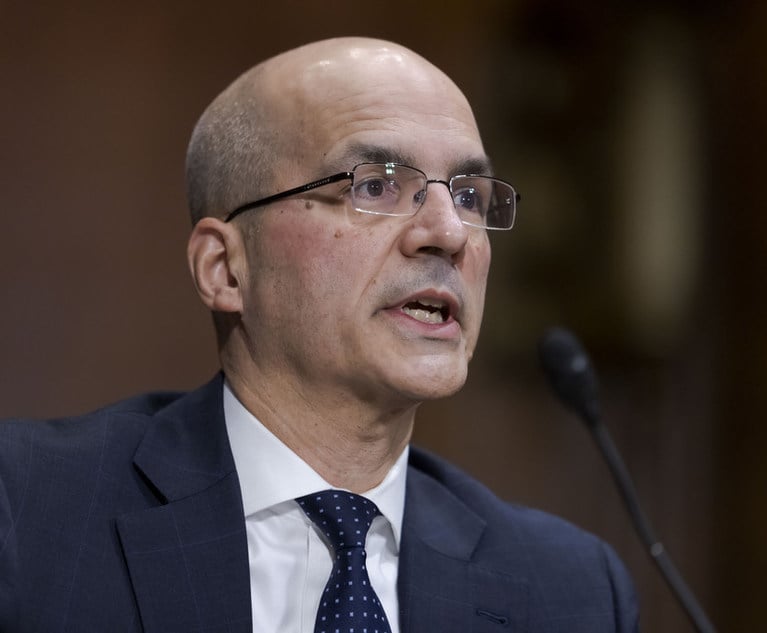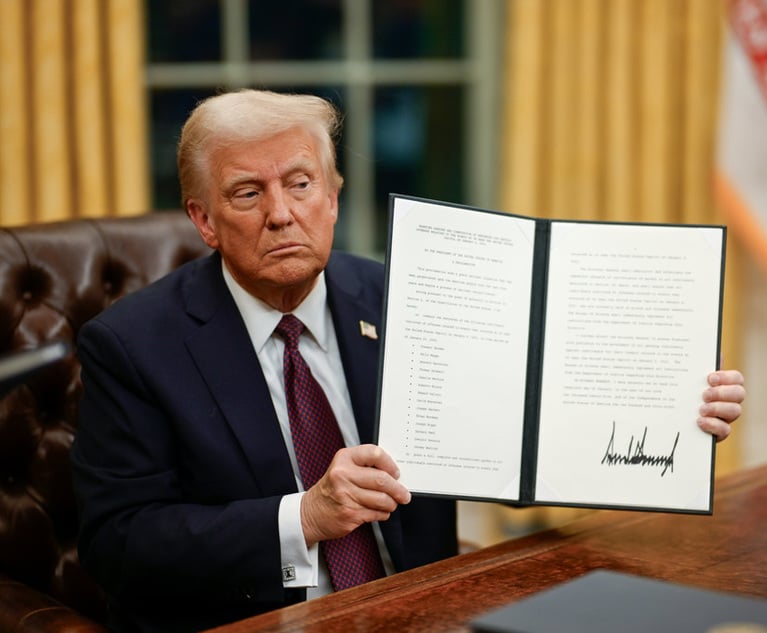After an Earthquake, More Tremors
Recently I wrote of a Judiciary Law §487 case in the Northern District of New York that violently altered the basic understanding of the elements…
November 13, 2017 at 02:45 PM
8 minute read

Recently I wrote of a Judiciary Law §487 case in the Northern District of New York that violently altered the basic understanding of the elements of this common-law cause of action. In the wake of that stunning Magistrate's report two other pillars of the Judiciary Law §487 world have fallen. “Judiciary Law 487 Suffers an Earthquake,” N.Y.L.J. (Sept. 20, 2017).
Truth and deceit are the two poles of human interaction. This is nowhere more revealed than in the client-patient-professional relationship. Humans willingly put their lives and fate in the hand of learned doctors and lawyers and suspend their normal distrust. So many times the work is good, often lifesaving. Sometimes, not.
Professionals have the superior knowledge upon which the public depends. Surgery, finances and trials all depend on learning, experience and some degree of talent. Dependence on superior knowledge is the basis of the fiduciary relationship. Clients and patients are in trouble or ill and need professional expertise. They surrender themselves to the experts.
In this relationship, surrender requires and implies great trust and confidence. That faith is overwhelmingly rewarded most of the time. To support this relationship, attorneys' superior knowledge of law and situational detail leads to the fiduciary requirement of greater loyalty by the attorney to the client than one finds in the marketplace. Failure to honor that loyalty can allow the attorney to take advantage of the client.
Attorneys and other fiduciaries are held to a higher standard, and in the case of attorneys, Judiciary Law §487 has existed in some form from medieval times to regulate attorney conduct. It defines acts intended to deceive the court or any party as a misdemeanor and sets treble damages as a penalty. It specifically deals with attorney deceit, not good faith mistakes.
This stuff is elementary and ancient. JL§487 is not a statute—it's the common law. It first arose in England just years after the Magna Carta (1215). The common-law principle against attorney deceit arose in 1275, was imported into New York and remains in effect today.
It became part of New York's common law as part of the “Colonial-era incorporation or 'reception' of English law into New York law.” The law of England and the statutes which were accepted by New York in 1787 became the common law of New York.
In recent years, Amalfitano v. Rosenberg, 12 N.Y.3d (2009) held that an intent to deceive, rather than a completed deception is all that is necessary to trigger a successful Judiciary Law §487 case. A party which commences or continues an action grounded in a material misrepresentation of fact which requires that the opposing party defend or default may cause damage and necessarily creates legal expenses. At a minimum, these legal expenses may be treated as the proximate result of the deceit.
Proofs of the connection between deceit and damages have always been difficult. Courts permit application of the statute but set a very high standard. The First Department has written that relief “is not lightly given” and requires a showing of “egregious conduct or a chronic and extreme pattern of behavior on the part of the defendant attorneys that caused damages.” Facebook v. DLA Piper, 134 A.D.3d 610, 615 (1st Dep't 2015). The other departments permit a lower standard, and recognize that a single egregious incident is sufficient. Trepel v. Dippold, 2005 U.S. Dist. Lexis 8541 (S.D.N.Y. 2005) (citing multiple examples).
From this foundation, a swelling body of JL §487 law has grown. Two well known cases were Melcher and Dupree.
Melcher v. Greenberg Traurig, has been up and down from the Appellate Division more than once. It was heard there in 2006 and in 2008, 2011 and in 2016. It recently returned to the First Department again on appeal from Supreme Court's denial of summary judgment to defendants. In 2016 the Appellate Division forcefully and clearly held that it can be proper to “assert a Judiciary Law §487 claim in separate action rather than seeking leave to assert a claim against the attorney defendants [in the underlying] action” id. Furthermore, even if deceit is raised in the underlying action, it does not preclude the later JL §487 case.
The Melcher claim arose from the extraordinary handling of a paper document around which the entire case turned. A 1998 amendment to a law firm partnership agreement changed the formula for dividing profits. Melcher denied that the amendment even existed when his partner claimed it did. When the time came to examine it forensically, it was reported to be accidently burned in a kitchen fire while preparing tea. The signature page was “singed.” After trial, the First Department directed that a hearing be held on Melcher's claim that Brandon Fradd had “fabricated, backdated and intentionally burned” the paper amendment. It was asserted that the law firm deceitfully relied on the paper amendment and argued its veracity.
After its long litigation history, Melcher seemed destined for trial. Not so. After years of litigation, Justice Sherwood in Supreme Court, New York County rendered a devastating blow to plaintiff this year in Melcher v. Greenberg Traurig, 2017 NY Slip Op 31727, finding that Melcher cannot recover for lost damages from the underlying action due to deceit nor show that attorney deceit was the proximate cause of a decision to accept less in settlement. Only a thin slice of subsequent attorney fees might still be collectible.
Another summer shocker was the curious case of Dupree v. Voorhees, 153 A.D.3d 601 (2d Dep't 2017). There a partner of an attorney was held potentially and vicariously liable in the case based solely upon partnership principles, where the attorney did not participate in or ratify the wrongdoer's action. In a criminal prosecution, there can be no accomplice liability without some “acting-in-concert” proofs. “The plaintiff alleged that in an underlying divorce action, in which Villar represented the plaintiff's former husband, Villar made misrepresentations in applying for a receivership order and that she intended to deceive the court in connection with that application. The plaintiff alleged that because the defendants were partners of the same law firm, Courten was vicariously liable for the damages she sustained as a result of Villar's actions.”
The case went to trial and plaintiff lost. “Here, the evidence adduced at trial, including the testimony of Villar, supports the trial court's determination that Villar did not act with the requisite “intent to deceive the court or any party” in applying for the receivership (Judiciary Law §487[1]). A second longstanding pillar of JL §487 law had tumbled.
In any event, to succeed on a cause of action to recover damages under Judiciary Law §487, the plaintiff must demonstrate that he or she “suffered … damages which were proximately caused by the deceit allegedly perpetrated on him [or her] or on the court” O'Connor v. Dime Sav. Bank of N.Y., 265 A.D.2d 313, 314; see Manna v. Ades, 237 A.D.2d 264, 265; Di Prima v. Di Prima, 111 A.D.2d 901, 902). The evidence adduced at trial also supports the trial court's conclusion that the plaintiff failed to establish that she suffered pecuniary damages as a result of the alleged deceit. Therefore, we decline to disturb the trial court's determination.” Dupree at 603.
Finally, the latest disruption comes from an ongoing case from the U.S. District Court for the Western District of New York. Bounkhoun v. Barnes and Cellino & Barnes, Case No. 15-cv-631A now awaits a decision by District Judge Richard Arcara whether to accept the recommendation that no Judiciary Law §487 case may exist without a criminal prosecution. Magistrate Judge Hugh Scott recommended that an otherwise appropriate JL §487 be dismissed because no criminal conviction of the attorney had been obtained, nor had all elements of a criminal infraction by the attorney been shown. To that day, no court had interpreted JL §487 to require such a precondition. The Magistrate recognized that his was a novel interpretation and distinguished Schindler v. Issler & Schrage, 262 A.D.2d 226, 228 (1st Dep't 1999) and Wiggin v. Gordon, 115 Misc.2d 1071 (Civ. Ct. Queens, 1982), which held that “a criminal conviction is not a condition precedent to a civil action” under JL §487. Even though unprecedented, he nevertheless proposed dismissal.
Magistrate Scott wrote: “The Court is not aware of any prosecution of defendants under Section 487, and plaintiff in any event has not pled nearly enough detail to show that defendants might have fulfilled all of the elements of Section 487 and might be guilty of a misdemeanor. Without fulfillment of the elements of a criminal offense under Section 487, and a resulting conviction, this case presents no criminal prerequisite that treble damages can be 'in addition to.'”
Motion practice remains undecided before the District Judge on the Magistrate's report. No matter how the District Judge treats this Report, we expect an appeal to the Second Circuit, and perhaps a certified question to the New York Court of Appeals.
Andrew Lavoott Bluestone is an attorney in Manhattan specializing in legal malpractice litigation and an adjunct professor.
This content has been archived. It is available through our partners, LexisNexis® and Bloomberg Law.
To view this content, please continue to their sites.
Not a Lexis Subscriber?
Subscribe Now
Not a Bloomberg Law Subscriber?
Subscribe Now
NOT FOR REPRINT
© 2025 ALM Global, LLC, All Rights Reserved. Request academic re-use from www.copyright.com. All other uses, submit a request to [email protected]. For more information visit Asset & Logo Licensing.
You Might Like
View All
'Serious Legal Errors'?: Rival League May Appeal Following Dismissal of Soccer Antitrust Case
6 minute read
How Some Elite Law Firms Are Growing Equity Partner Ranks Faster Than Others
4 minute read
Trending Stories
- 1GOP-Led SEC Tightens Control Over Enforcement Investigations, Lawyers Say
- 2Transgender Care Fight Targets More Adults as Georgia, Other States Weigh Laws
- 3Roundup Special Master's Report Recommends Lead Counsel Get $0 in Common Benefit Fees
- 4Georgia Justices Urged to Revive Malpractice Suit Against Retired Barnes & Thornburg Atty
- 5How Gibson Dunn Lawyers Helped Assemble the LA FireAid Benefit Concert in 'Extreme' Time Crunch
Who Got The Work
J. Brugh Lower of Gibbons has entered an appearance for industrial equipment supplier Devco Corporation in a pending trademark infringement lawsuit. The suit, accusing the defendant of selling knock-off Graco products, was filed Dec. 18 in New Jersey District Court by Rivkin Radler on behalf of Graco Inc. and Graco Minnesota. The case, assigned to U.S. District Judge Zahid N. Quraishi, is 3:24-cv-11294, Graco Inc. et al v. Devco Corporation.
Who Got The Work
Rebecca Maller-Stein and Kent A. Yalowitz of Arnold & Porter Kaye Scholer have entered their appearances for Hanaco Venture Capital and its executives, Lior Prosor and David Frankel, in a pending securities lawsuit. The action, filed on Dec. 24 in New York Southern District Court by Zell, Aron & Co. on behalf of Goldeneye Advisors, accuses the defendants of negligently and fraudulently managing the plaintiff's $1 million investment. The case, assigned to U.S. District Judge Vernon S. Broderick, is 1:24-cv-09918, Goldeneye Advisors, LLC v. Hanaco Venture Capital, Ltd. et al.
Who Got The Work
Attorneys from A&O Shearman has stepped in as defense counsel for Toronto-Dominion Bank and other defendants in a pending securities class action. The suit, filed Dec. 11 in New York Southern District Court by Bleichmar Fonti & Auld, accuses the defendants of concealing the bank's 'pervasive' deficiencies in regards to its compliance with the Bank Secrecy Act and the quality of its anti-money laundering controls. The case, assigned to U.S. District Judge Arun Subramanian, is 1:24-cv-09445, Gonzalez v. The Toronto-Dominion Bank et al.
Who Got The Work
Crown Castle International, a Pennsylvania company providing shared communications infrastructure, has turned to Luke D. Wolf of Gordon Rees Scully Mansukhani to fend off a pending breach-of-contract lawsuit. The court action, filed Nov. 25 in Michigan Eastern District Court by Hooper Hathaway PC on behalf of The Town Residences LLC, accuses Crown Castle of failing to transfer approximately $30,000 in utility payments from T-Mobile in breach of a roof-top lease and assignment agreement. The case, assigned to U.S. District Judge Susan K. Declercq, is 2:24-cv-13131, The Town Residences LLC v. T-Mobile US, Inc. et al.
Who Got The Work
Wilfred P. Coronato and Daniel M. Schwartz of McCarter & English have stepped in as defense counsel to Electrolux Home Products Inc. in a pending product liability lawsuit. The court action, filed Nov. 26 in New York Eastern District Court by Poulos Lopiccolo PC and Nagel Rice LLP on behalf of David Stern, alleges that the defendant's refrigerators’ drawers and shelving repeatedly break and fall apart within months after purchase. The case, assigned to U.S. District Judge Joan M. Azrack, is 2:24-cv-08204, Stern v. Electrolux Home Products, Inc.
Featured Firms
Law Offices of Gary Martin Hays & Associates, P.C.
(470) 294-1674
Law Offices of Mark E. Salomone
(857) 444-6468
Smith & Hassler
(713) 739-1250







